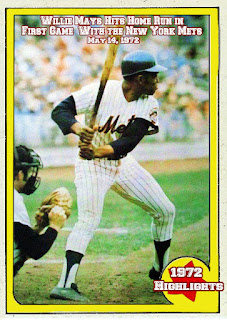Mays was streaky, especially late in his career. And the truth is he slumped badly early and late in 1972 and 1973. But as a role player, check out mid-season numbers, especially 1972. He was not the "Willie Mays" everyone had grown to know from 1951-71 but he was not the caricature some make him out to be with Mets—Too old to play, cannot field anymore. Those, in our view, were exaggerated to a large degree.
In 1972 when he arrived he hit a homer in his first game and from that day through August 20 he hit .288 with 8 home runs.
The next year he again slumped early then on April 28, again in spot duty, hit .249 with six home runs through August 24th.
Of course, his seasons' totals were not as good because of the aforementioned early- and late-season slumps.
But consider in 1973, for example, during that April 28 to August 24 period, here is what the Mets heavy hitters did.
Staub hit .286 but his OPS was .785 and he hit 8 home runs over 220 more at-bats.
The Mets regular centerfielder was Don Hahn. He was hurt early in the season and came aboard in June and hit .238 but with no power. From June 16 through June 23th had a .409 average, accounting for nine of his 40 hits in this mid-season span we are examining.
Left fielder Cleon Jones during this span—
Third baseman Wayne Garrett had some pop in his bat hitting 9 homers in this span, three more than Mays but a lot more at-bats, and his slugging and OPS were both below .350.
In 1973 Ed Kranepool played first base and some left field. he was usually good for 9-10, 13 more homers a season. But in 1973 he began a period where he had a decent average but his power dried up hitting .288 from 1973-75 but average only three dingers a season. Then, in 1976, his power picked back up to its pre-1973 levels. Odd.
So, when Mays had hit good stretch in the middle of the season his stats were not great. However, on that team, they were helpful to a team that was built on dominant pitching (Seaver, Koosman, Matlack, and McGraw) and excellent fielding.
Here is the team stats for the 108-game span we are discussing—
The team hit .249 had a slugging percentage of .339.
The year before it was similar.
From May 14, 1972 through August 20, 1972—
Tommy Agee hit .233 with 7 HR and 25 RBI and his OPB was .332 and .384 was his slugging and he had a .716 OPS.
John Milner hit .248 and 10 HR with 25 RBI and a .347 OBP and a .439 slugging and a .786 OPS.
Cleon Jones hit .232 and his .301-.320-.621 were is OBP-SLG-OPS
Again, Mays .288 8 HR 19 RBI and a .434 OBP, and .497 SLG and a fine .931 OPS.
As for the errors in the field in the 1973 World Series, they happened. And they happened to others as well.
 |
| Cleon Jones lost one in the Sun |
 |
| Joe Rudi lost one in the Sun |
And Willie had his well-documented troubles as well—
He had also got a short chopper that broke open Game 5 of the NLCS and sent the 82-80 Mets to the World Series
So while we are cherry-picking his midseasons of 1972 and 1973 and downplaying his early season and late season slumps (he was 41 and 42 years old) we just don't think it is fair that his error and losing a ball in the sun when other players did it is reasonable, this is to say, to blame it on his staying in the game too long. Maybe he did, but that was no proof of it.
Yes, you could say 1972 and 1973 were not productive. We buy that. They were two seasons of good production in the middle of the year as well, as good as or better than most players on his team. So let's just remember that.
















No comments:
Post a Comment